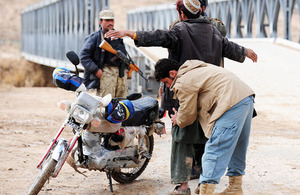2011 'crucial to the future of Afghanistan'
The importance of 2011 to Afghanistan's future was highlighted by representatives of the Foreign and Commonwealth Office (FCO), Ministry of Defence, and Helmand Provincial Reconstruction Team (PRT), at a press conference in London yesterday, 19 April.

Afghan National Civil Order Police (ANCOP) officers search road users at a police check point next to the Friendship Bridge in Nad 'Ali [Picture: Leading Airman (Photographer) Iggy Roberts, Crown Copyright/MOD 2011]
At the briefing, held at the FCO, Karen Pierce, Special Representative on Afghanistan and Pakistan, said that 2011 would be crucial in consolidating gains and securing the conditions for the nascent transition process that Afghan president Hamid Karzai announced on 22 March:
By 2014, Afghanistan should look very different from how it looks now,” Ms Pierce said.
Obviously a lot of our focus is on ensuring that the peace dividends from transition experienced by the various communities in those provinces that are due transition.
That means a certain amount of help to get the local governor and local governance issues sorted out, and a certain amount of help for the Afghans to disperse funds from the centre to the provinces, so that the people there get a very immediate sense of improvement in goods and services from the [Afghan] government.
Ms Pierce added that, as transition evolves, the NATO Enduring Partnership, announced last week, will provide a range of partnership schemes between NATO and Afghanistan, covering areas such as training, mentoring and Defence diplomacy.
Running allied to this was a political process focused on reconciliation, she explained. The High Peace Council within Afghanistan, led by Borhanuddin Rabbani, has been very active on this front and had engaged on several trips around Afghanistan and has started to some elements of the insurgency in initiative supported by the British government and International Security Assistance Force (ISAF).
Focussing more on Helmand province, where most of the British forces in the country are based, Michael O’Neill, head of the PRT, said that there had been increasing progress over the last 12 to 18 months. He warned, however, that this remained fragile, and the key challenge over the coming months would be to consolidate this progress and ensure its sustainability over the medium and long term, as the Afghans take the lead.
Mr O’Neill said:
I think if you look at central Helmand in particular, where the main population centres are Lashkar Gah, Gereshk, and the communities in between, you can see quite significant progress in the establishment of district governance, local governance, district councils, district governors, who have teams around them of ministry officials from Kabul, and similarly in Justice, with more judges and prosecutors now deployed.
He went on to say that Afghan National Security Forces had shown a marked increase in number, as well as quality; a result of initiatives such as literacy classes, and leadership courses for NCOs.
I think, for me, Marjah is a particularly striking example,” Mr O’Neill said. “It is just over a year since Operation MOSHTARAK, which proved to be a long and difficult campaign, and, when I first visited [Marjah] on a recce in January last year, you couldn’t get off the base.
I went back in November last year, and a couple of times since then, and you can now walk freely around the centre, visit restaurants, you can chat to people on the streets, and economic life is really taking off; you can see construction all around.
Mr O’Neill said there were also very encouraging signs in Sangin, an area in which British forces have previously invested a lot of effort, with Helmand Governor Mangal reaching out to local tribes.
Throughout all the progress seen is an increasing sense of an ‘Afghan lead’ with Afghan security forces leading and planning more and more operations, especially in central Helmand, added Mr O’Neill:
In Lashkar Gah itself, security is led by the Afghan Army and Police, and the only time you see ISAF troops is when they are transiting through the city to other parts of the district,” he said.
However, Mr O’Neill warned that the security situation in other areas of the Province remains challenging, and there is still low capacity within civil institutions, emphasising that further consolidation was still required.
On the security situation, Major General John Lorimer, The Chief of Defence Staff’s Strategic Communications Officer, said that, in many ways, the positive progress achieved by Afghan and ISAF security forces was reflected in the changing tactics of the insurgency seen in recent months.
Citing recent examples of the attack on the Kabul Defence Ministry and the UN compound in Mazar-e-Sharif, he said such ‘spectaculars’ were expected, and a reflection of the state of the insurgency as it is shifted away from communities.